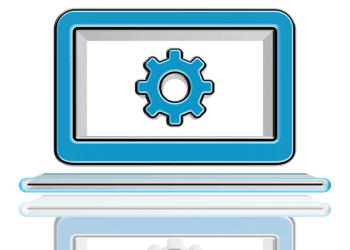Modern businesses absolutely need to have a good understanding of their bandwidth requirements. How much data do you share daily? How fast do you need to share it? While Bandwidth is often measured in speed, this can be misleading. When determining the best bandwidth speed for your business, think of your bandwidth requirements in terms of capacity.
Bandwidth Defined
Bandwidth is the capacity of your network to transmit data. A simple plumbing illustration can make things clear: bandwidth is like water flowing through a pipe. How much water the pipe can transfer over time is similar to bandwidth.
“The maximum amount of water possible is like the maximum possible data transfer rate of your network. In this way, bandwidth is synonymous with capacity. Therefore, if you need more water, install a larger pipe. If you need more data transfer capacity, raise your available bandwidth.”
The bandwidth requirements for your business depend mainly on how much data you use and share on a regular basis. Every industry and individual business must review the number and types of connected devices used, and the amount of data that is shared, in order to calculate an accurate appraisal of bandwidth requirements.
Calculating Bandwidth Requirements for Different Industries
Various industries will have different bandwidth requirements, depending on how they use data. For example, retail industries that do a large amount of business over the Internet will have huge data needs. Consumers will be viewing product images, reading text about products, adding selections to their shopping cart, making purchases using secure financial data, and communicating with the business about other needs and options.
Other industries may use more connected monitoring or communication devices to send data to a central hub for storage or action. Still more industries may send loads of financial data that all must be completely secure, while others may send measurements or other information with less or no security requirements.
Here are some common industries and their typical demands for data:
Automotive
Modern vehicles are equipped with an array of factory-installed electronic components that gather data. As far back as 2014, a McKinsey & Company study estimated that connected vehicles generate around 25 GB of data each hour of operation. Fast-forward to today, and how much could that number have increased? Today’s autos come with sensors, cameras, ECUs, and more that generate real-time data. This data is then captured and collated by various stakeholders.
Consider also the bandwidth requirements involved on the manufacturing side of the automotive industry. There also, one finds numerous sensors, monitoring devices, and more that drive the manufacturing process, helping with quality control, shipping, and safety.
Biotechnology
The Biotech industry is rushing to adopt advanced technologies that use the Internet of Things (IoT) to facilitate even better outcomes in agriculture, pharmaceuticals, safety, and secure data transmission. Consider all the components and devices used in biotech that provide real-time data over a local network and the Internet:
- Actuators
- Irrigation Modules
- Photovoltaic Panels
- Power Supplies
- Sensors
- Scanners
- Security Modules
- Tracking Devices
- Transceivers
- Wearables
Construction
Construction has evolved into an industry that is highly dependent on technology and real-time data.
- AI that records data from how workers move about the site
- Digitized safety mechanisms collect data on work processes
- Apps help site managers track every member of the construction team in real-time
- Mobile applications improve measurements, placement of objects, and inspections
- Automated drones and ground-based site rovers make accurate photo records
- Drones are programmed to inspect and count material inventories
Consider also that many construction sites are far removed from available fiber networks, so their connectivity solutions for adequate bandwidth requirements can be especially difficult.
Education
Today’s education industry demands that colleges and universities be fully accessible online to remain competitive. Students and faculty alike require advanced technology and connectivity options to facilitate learning, finances, research, and administration. How many students depend on an app or web board to keep up with classes, assignments, financial payments and scholarship data, communication with instructors, and even digital books from the library?
This hyperconnected learning environment is also populated with students that spend enormous amounts of time on the Internet for other pursuits as well. Streaming games, television, videos, as well as digital learning components, demands a provider that can offer scalable bandwidth requirements to meet increasing demands.
Financial
Banks and other institutions in the financial industry move incredible amounts of data each day. Both employees and customers demand fast access to data that must also be secure. The national and global economy relies on fast, secure transfer of financial data. Delays from problems with bandwidth requirements can mean lost deals, lost customers, and lost revenue.
Government
As governments provide more resources for citizens, government organizations must be aware of their own bandwidth requirements for providing easy-to-use, reliable, and dependable online support. Much of this data must also be secure and meet the demands of various privacy guidelines. Plus, many government organizations share data, making it necessary for a huge, interconnected (traditionally slow and inefficient) entity to operate even more efficiently.
Healthcare
The healthcare sector has leapt eagerly into the digital age with increasing connectivity and data-sharing capabilities. Approximately 50% of healthcare IoT is used for remote operation and control, and 47% connect their devices to location-based services. Electronic Health Records (EHR) has almost reached universal adoption, allowing hospitals and other providers to share secure patient medical information with a few clicks.
All this connectivity must be fast and secure to meet patient care needs while meeting HIPAA and other regulations for privacy. The COVID-19 pandemic caused this need to increase exponentially, as remote testing centers and an increase in patient load placed incredible demands on healthcare providers and institutions.
Hospitality
Technology is often overlooked in the hospitality industry. Hotels and other hospitality-related venues increasingly depend on higher bandwidth requirements to meet the demands of client conveniences and needs. Providing better in-room experiences, adequate needs for large conferences, expedited resource planning, and reservation planning all relies on fast, reliable Internet connectivity and networking.
Warehousing
Logistics and warehousing in our modern age relies heavily on demanding bandwidth requirements. Consider how tracking, storing, and delivering an incalculable number of goods is made easier and faster with modern data-transfer technology:
- Digital inventory control sensors and counters
- Drones to monitor and assess inventory levels
- Smart damage detection devices
- Handheld scanners connected to the IoT
- Digital shipping manifests shared with several stakeholders
What Are Your Bandwidth Requirements?
Think about your unique business and how much data you use/share daily. How many users are connected? How many automated devices? Consider all this when calculating your bandwidth requirements. Below is a general guide of how much bandwidth you may require.
- Low (20 Mbps or less) — Few users, with connected laptops, desktops, E-fax machines, VoIP phones; email and web research are most of your active usage.
- Medium (50-500 Mbps) — Few users, but with more intensive web browsing, research, streaming, emailing, and downloading larger files.
- High (100-200 Mbps) — A number of users that take regular advantage of cloud-based platforms and software programs (CRS, PoS, ERP, etc.). High flow of email and downloads.
- Intense (200-500 Mbps and higher) — A number of users that regularly employ HD video conference devices and platforms, large data transfers, constant flow of data between branch locations.
A handy tool to help with your calculations is MHO’s Download Simulator. This free online tool illustrates how long it would take to download a variety of files on different bandwidth speeds per employee. Try it now and get a feel for your company’s bandwidth requirements.
You can also contact the Internet and connectivity specialists at MHO with your questions about scalable bandwidth needs, Fixed Wireless Internet and Networking, and our availability in your area.
{{cta(‘1b7ff105-cbb6-486e-888d-bb72f7746c39’)}}




![[Infographic]: What is Microwave Transmission](https://blog.mho.com/wp-content/uploads/2017/10/Screenshot-2025-06-24-141523.png)

